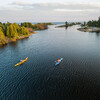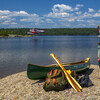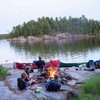
Pride, Confidence and Connection


The City of Thunder Bay would not exist if it weren’t for canoeing. That might sound like an outlandish claim, but consider that the area’s earliest inhabitants travelled by canoe as did the Europeans that followed hundreds of years later in search of fur. For proof, look no further than the Canadian Canoe Museum’s logo—a replica of a mazinaawbikinigeen (pictograph) on the cliffs of Pictured Lake and Fort William Historical Park, the world’s largest reconstructed fur-trading post, both of which are located just outside of the city.
Fur traders learned to navigate the intricate web of rivers and lakes from Indigenous peoples who also passed along their knowledge of canoe-building. Using materials from the earth—birch bark, white cedar, and spruce roots—they built vessels to withstand the rugged terrain of the Canadian Shield, and the heavy loads of supplies and furs hauled to and from remote trading posts.
Nowadays, there are not many birch bark canoes in the Thunder Bay area outside of those used for re-enactments at Fort William Historical Park. But, a group of youth from Fort William First Nation—the community whose ancestral lands include the famous pictograph—are working to change that.

For the past two years, Gail Bannon, Fort William First Nation’s community and recreational coordinator, has lead youth who have built two birchbark canoes completely by hand in the tradition of their ancestors. Bannon learned the ins and outs of canoe-building from Darren Lentz, who learned the craft while working at Fort William Historical Park and from elders at Fort William First Nation.
When Bannon and Lentz started talking about building canoes in 2015, she realized that she didn’t know of anyone in her community with knowledge of canoe-building. “I don’t know of anybody in my mother’s generation that knows—and maybe they do, but they just don’t do it any more. And I thought: how could we have lost that?”

Youth were eager to sign up for the project, but in the end it was a small but dedicated group that persevered and completed each canoe. Tanya Fenton, who supervised the group in 2016, says it was the opportunity to work outdoors as part of a team that attracted youth, such as her daughter Shaylah. Lentz says the experience was positive for all of the youth involved, whether they only participated in the early stages or stuck it out until the canoe was completed. “They take away what they need at the time; it’s about building relationships with one another, their culture, and the land.”
Bannon echos this sentiment, “Working up on Anemki Wajiw [Mt. McKay], I think it is the perfect key to getting these kids outside and experiencing, not only nature, but the land that they live on.” She knows building a canoe is meaningful to the youth: “it’s not just sitting in an office or you’re not just doing somebody’s grunt work, they get to actually build something... it’s not something you’re done in a few hours, it’s a lot of touching and feeling—they get to really experience the materials that we use.”

An integral part of the build is collecting all of the materials used from the land. As Fenton says, “it’s incredible to be able to know how to build something from scratch.” The youth learn how to choose and harvest materials and use them wisely; “they show great respect for the resources because they know how much work it is to get them,” says Lentz. Bannon believes there is a deeper lesson in all of this, and that showing respect for the resources is showing respect for oneself.

Perhaps one of the proudest moments for the youth involved in canoe building is when elders visited, and expressed their happiness at seeing them learning a traditional craft and connecting with Ojibwe culture.

“It’s all about teaching the youth so that they can pass it on,” says Bannon. “What the whole practice of building a canoe does for you with self-confidence and pride, trying new things and being more connected to the environment.”

learn more about traditional canoe-building
In the Thunder Bay area, stop by the pow wow grounds on Anemki Wajiw during the summer and you might just see the youth of Fort William First Nation in the midst of a build or visit Fort William Historical Park. In Peterborough, visit the Canadian Canoe Museum.
learn more about Ojibwe culture
Participate in one of Fort William First Nation’s pow wows which happen annually in the spring and fall. The community is located just outside of Thunder Bay and is nestled between the Kaministiquia River, Gitchi-Gami (Lake Superior) and (Anemki Wajiw) Mt. McKay and offers numerous opportunities for paddling and hiking. Local restaurants offer home-cooked meals (go for the pickerel!).
Don’t Miss
The lookout at Anemki Wajiw (Mt. McKay) offers a spectacular view of Thunder Bay; there is a nominal toll collected by Fort William First Nation.
POINTS OF INTEREST
REGIONAL TOURISM INFORMATION
Recommended Articles
7 photography tips
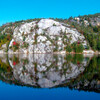
KILLARNEY MAGIC
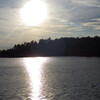
Backcountry Paddling

Backcountry in the Boreal

Bald Eagles, Herons & Moose

Guide to the Maukinak Trail

Paddling into the Past: Ontario Ghost Town Canoe and Kayak Routes

Chips and Canoes

Paddling in Lady Evelyn Smoothwater
Best River Canoe Trips

Best Lakes for Paddling
Sea Kayak Lake Superior

Go With the Flow

Must-Visit Lakes in Quetico
Discover Paddling Escapes In Timmins

Paddling Vacations From Ottawa

Top 10 Easy Canoe Trips

Learn or Improve Your Paddling Skills
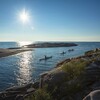
So Many Places to Paddle








